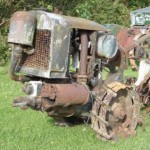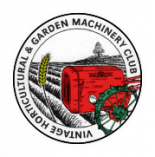Home › Forums › The Main Forum Area › Projects › SIMAR M11 slow restoration.
- This topic has 26 replies, 5 voices, and was last updated 10 years, 7 months ago by
 charlie.
charlie.
-
AuthorPosts
-
March 22, 2014 at 4:30 pm #6740
 charlieKeymaster
charlieKeymasterI thought it was about time I started a topic covering the very slow restoration of the SIMAR M11 I have. It all started back in 2004 when I collected these two machines from Sussex. One machine has V twin and radiator behind, not sure of the model. Sadly this machine is in a very poor condition with parts missing such as the magneto and will probably not be restored.
The other machine with radiator on the front and single cylinder 2 stroke engine, is the M11. The photos below show both machines after I had unloaded them.March 22, 2014 at 4:38 pm #6745 charlieKeymasterMarch 22, 2014 at 4:47 pm #6750
charlieKeymasterMarch 22, 2014 at 4:47 pm #6750 charlieKeymasterMarch 22, 2014 at 4:47 pm #6755
charlieKeymasterMarch 22, 2014 at 4:47 pm #6755 vhgmcbuddyMember
vhgmcbuddyMemberAbout on a parr, resto wise with the two A56’s I started with Charlie They took me nearly 5 years but good luck and I will be watching as you progress.
March 22, 2014 at 4:48 pm #6756 charlieKeymasterMarch 22, 2014 at 4:51 pm #6759
charlieKeymasterMarch 22, 2014 at 4:51 pm #6759 charlieKeymasterMarch 22, 2014 at 4:54 pm #6763
charlieKeymasterMarch 22, 2014 at 4:54 pm #6763 charlieKeymasterMarch 22, 2014 at 4:57 pm #6765
charlieKeymasterMarch 22, 2014 at 4:57 pm #6765 charlieKeymasterMarch 22, 2014 at 5:00 pm #6768
charlieKeymasterMarch 22, 2014 at 5:00 pm #6768 charlieKeymasterMarch 22, 2014 at 5:13 pm #6770
charlieKeymasterMarch 22, 2014 at 5:13 pm #6770 charlieKeymaster
charlieKeymasterThis was about as far as I got in 2005.
Major problems identified, fuel tank rotted out, tin work around rotors almost non existent, engine side covers rusted through in places and hinges broken. Handle bar adjustment to swing left or right seized solid and something certainly not right with big end of engine as it would only rotate so far. Magneto would need a full rebuild and radiator was an unknown regarding leaks. I took the radiator away to have it tested and was very pleased to find it was OK.
After much heating, soaking with penetrating oil, gentle taps with soft hammer the handle bar adjuster sleeve was still firmly stuck. I decided a bit more persuasion was needed so using a flat ended bit in the SDS drill set to hammer only I attacked the sleeve. Holding the drill against one end of the sleeve a gentle plume of smoke like rust emerged from the other end, something was happening! Further application of the drill to both ends alternating between them and eventually there was movement, success.
The next job was to tackle the engine and clutch. It was now January 2006.March 22, 2014 at 5:15 pm #6774 charlieKeymaster
charlieKeymasterStripping the clutch, which is a cone clutch, revealed a new lining would be required. This was carried out by a clutch and brake relining company, not cheap, but a very necessary job. Little did I know just how much more this restoration was going to cost!!
March 22, 2014 at 5:24 pm #6775 charlieKeymaster
charlieKeymasterI had initially thought this was a M10 Rototiller although the air cleaner did not look right and the only photo I had seen was in the booklet ‘Experiences of Rototillage’. A trawl through the very good SIMAR website, motoculteur-simar confirmed my suspicions and I was able to identify it as an M11. Photo’s below courtesy of the website mentioned.
March 22, 2014 at 5:32 pm #6778 charlieKeymaster
charlieKeymasterWhen I pulled the engine apart I found why it would not rotate fully, the big end roller bearing had broken up. This was not going to be an easy fix. Unsure of where to take the engine I phoned Cox & Turner and after a good chat with Ian Cox he confirmed they could do the work. So the engine was taken to them for a new big end bearing to be made, new crank seals fitted and magneto rebuilt by someone they knew. They were unable to get any seals that would fit the crank and crankcase so it was agreed the case would be machined to enable new seals to be fitted. A new roller bearing had to be made to order for the big end. Yes all this did cost a fair bit.
March 22, 2014 at 5:48 pm #6779 charlieKeymaster
charlieKeymasterThis is what was left of the big end bearing and damage it had caused to crank pin. The photo of the crank pin shows where the locating dowel goes and how the end of the crank pin is split, another dowel goes in the end to open the split and lock the whole lot to the crank web. This proved to be a bit of a challenge to remove as only a small diameter drift could be used which had a tendency to bend.
Due to workload and my saying the job was not urgent it took a while before I was able to collect the engine but it was well worth the wait. A crack in the water jacket also had to be repaired, luckily it was only the outer and had not damaged the bore. Photos of the parts at Cox & Turner awaiting reassembly.March 22, 2014 at 5:52 pm #6785 charlieKeymaster
charlieKeymaster -
AuthorPosts
- You must be logged in to reply to this topic.
































